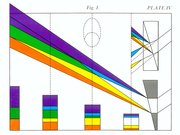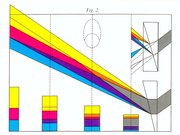Optical spectrum
|
|
Spectrum4websiteEval.png
approximation to the white light spectrum dispersed via an EdmundScientific Spectroscope or a 4x8 sheet of diffraction grating.
The optical spectrum (light or visible spectrum) is the portion of the electromagnetic spectrum that is visible to the human eye. There are no exact bounds to the optical spectrum; a typical human eye will respond to wavelengths from 400 to 700 nm, although some people may be able to perceive wavelengths from 380 to 780 nm. A light-adapted eye typically has its maximum sensitivity at ~555 nm, in the yellow region of the optical spectrum.
Wavelengths visible to the eye are defined by the spectral range of the "optical window", the region of the electromagnetic spectrum which passes largely unattenuated through the Earth's atmosphere (although blue light is scattered more than red light, which is the reason the sky is blue). Electromagnetic radiation outside the optical wavelength range, or other transmission windows, is almost entirely absorbed by the atmosphere.
| Contents [hide] |
Historical use of the term
Sir Isaac Newton first used the Latin word spectrum (appearance or apparition) in print in 1671. He was describing the phenomenon of colored bands dispersing from white sunlight passing through a prism.PrismAndLight.jpg
Newton's experiment
When a narrow beam of light strikes the face of a glass prism at an angle, some is reflected and some of the beam passes into the glass. All light travels at the same speed in a vacuum, but in transparent matter, Newton hypothesized that different colors (frequencies) move at different speeds. Red light moves more quickly in glass than violet light and it bends (refracts) less sharply. A triangular prism is shaped to bend the light twice, and disperse it as much as possible. The result is the spectrum of colors.
Color spectrum as a compound phenomenon
According to Goethe, when light shines through a prism, we are simply projecting a picture whose aperature has edges -- there is darkness outside this circular patch, and relatively light within it. We notice that it is at the edges between the light and dark areas where Colours first make their appearance.
When the aperature is sufficiently small so that the edges meet in the middle to form the green -- only then can you see a continuous spectrum. A wider aperature brings us to the primal phenomenon -- a reddish/yellow on some edges, and a bluish/cyan on the others. The continuous spectrum with green in the middle arises only where the (blue-cyan and yellow-red) edges come close enough to overlap.
We no longer see the original phenomenon when we make so small a circle that the colours extend inward from the edges to overlap in the middle to form what is called a 'continuous spectrum', while with the larger circle, the colours formed at the edges stay as they are.
Thus, for Goethe, the primal phenomenon is that Colours arise at the borders where Light and Dark work together, and the Spectrum is a secondary, compound phenomenon.
Light and dark spectrums
In the Goethean view, the spectrum is a compound phenomenon. In the familiar prisimatic experiment, you get colour at the edges, and where the red-yellow and blue-violet edges meet, you get green in the middle.
Because the colour phenomenon relies on the adjacency of light and dark, there are therefore two ways to produce a spectrum -- with a light beam surrounded by dark, and with a dark beam surrounded by light.
Spectroscopy
The scientific study of objects based on the spectrum of the light they emit is called spectroscopy. One particularly important application of spectroscopy is in astronomy, where spectroscopy is essential for analysing the properties of distant objects. Typically, astronomical spectroscopy utilises high-dispersion diffraction gratings to observe spectra at very high spectral resolutions. The first exoplanets to be discovered were found by analysing the doppler shift of stars at such high resolution that variations in their radial velocity as small as a few metres per second could be detected - the presence of planets was revealed by their gravitational influence on the motion of the stars analysed.
See also
| Electromagnetic Spectrum
Radio waves | Microwave | Terahertz radiation | Infrared | Optical spectrum | Ultraviolet | X-ray | Gamma ray Visible: Red | Orange | Yellow | Green | Blue | Indigo | Violet |


